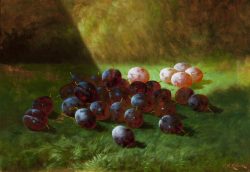- Categories
- Still lifes
- Zoom in on Artwork
- Print Page
- Email Page to Friend
From fresh and dried fruit to cookies, wrapped candies, and iced cakes, a generous array of dessert treats tempts the viewer in C. P. Ream’s still life painting. As bountiful as these foods are the vessels holding them, notably the matched set of basket on the left, the sugar bowl and creamer on the right, and the tall mounted bowl that commands the center of the arrangement. These are placed on a marble tabletop (the edge of which bears the artist’s signature, at the right) against a plain dark background. Before them, ripe raspberries, green grapes, and an orange are set on a fringed yellow napkin, their perfect forms and lustrous surfaces contrasting with clusters of dessicated purple grapes and a solitary almond in the shell. All these things are delineated with a somewhat hard, literal realism that minutely inventories the distinct materiality of each object without distracting the viewer’s attention to artistic process, technique, or materials. If Ream intended to communicate a moral message through the juxtaposition of such contrasting objects as the fresh and preserved fruit, that end is subordinated to stimulating our anticipation of sensual pleasure.
A Regal Dessert, the title of a painting Ream exhibited at the Interstate Industrial Exposition in 1874, certainly describes this image. Until he moved to Chicago in 1878, Ream worked in New York, in close competition with his brother, Morston Constantine Ream, also an accomplished painter of still lifes. In the early part of his career, C. P. Ream specialized in the elaborate tabletop compositions that were highly popular during the prosperous Gilded Age, particularly the so-called dessert or dining room pictures intended to be displayed where the foods represented in them might be consumed. Such images offer a rich variety of edibles—including fruit, sweets, fish, and game—vying for admiration with luxurious vessels of glass, ceramic, or silver, often set on a surface of marble, highly polished wood, or tapestry. Ream abandoned these manufactured objects as well as interior settings in such later works as Plums, of the mid-1890s.
The pearl-handled knife at left that extends toward the viewer, a time-honored device to demonstrate the artist’s facility with the illusionistic construction of three-dimensional space, links Ream’s art to a still-life tradition with roots in seventeenth-century Holland. Other features of the picture locate it firmly in Ream’s time, however. The metalwork containers, with their repetitive pattern, dull finish, and decorative contrasts of light and dark, appear to be examples of Britannia ware (a pewter alloy) or electroplated silver, the production of which boomed in the mid-nineteenth century, bringing ornate serving pieces to middle-class consumers on a mass scale; the angular style of the handles of the sugar bowl and creamer are characteristic of the 1870s. The grapes and raspberries, two fruits not naturally available at the same time of the year, and the orange, a product of tropical regions, testify to the broad range of luxury foods increasingly within reach of status-conscious Americans, while the varied fancy cookies and colorfully wrapped sweets are conspicuously store-bought rather than homemade, marking yet another innovation of the era’s urban culture. The artist may have chosen these foods not only to trumpet the enhanced accessibility of such dainties but with an eye to their variety of rich color. In the 1870s several of Ream’s paintings of this type were reproduced as chromolithographs by the Boston publisher Louis Prang & Company.
Wendy Greenhouse, PhD
Donated by M. Christine Schwartz to The Richard H. Driehaus Museum, Chicago, Illinois, in 2021

